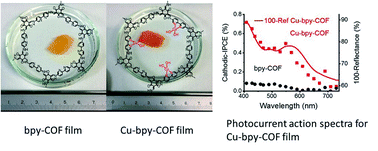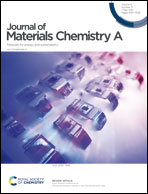Metal-doped bipyridine linked covalent organic framework films as a platform for photoelectrocatalysts†
Abstract
The development of efficient photoenergy conversion systems is highly demanded from the viewpoint of solving energy and environmental problems. Covalent organic frameworks (COFs) have attracted much attention as novel photofunctional materials because of their wide-range visible-light absorption, which is related to their large π-conjugation systems. The other important property of COFs is their ability to support a wide variety of metals via coordinate bonds; metal-doped COFs exhibit various electron-transfer catalytic activities depending on the metal species. Here, we newly synthesized free-standing metal-doped COF films as photoelectrocatalysts and evaluated the photoelectrochemical oxygen reduction reaction (ORR) properties of Cu atoms doped in a COF. The photocurrent corresponding to the ORR started to increase under 670 nm irradiation, and the photocurrent for the Cu-doped COF was five times larger than that for the COF without Cu. The action spectra, fluorescence spectra, and in situ X-ray absorption spectra indicate that the electrons photoexcited in the COF were transferred to oxygen via the Cu atoms. Thus, the Cu atoms coordinated to the COF serve as active catalytic sites for the photoinduced ORR.



 Please wait while we load your content...
Please wait while we load your content...